Written by Elizabeth Heffernan, RAHS volunteer
The twice-a-day Amiens train rattles into Villers-Bretonneux station, dead autumn leaves swept to the sides of the platform and rusted overpass looming above the tracks. The small, French village is silent, cobbled streets empty in the early morning gloom. Google Maps points the way past the houses and into the fields beyond; the path laid out before us is slippery with mud and wet cut grass. Fresh rain promises.
It is three kilometres from the village to the memorial, says Google. In reality it is longer, accounting for pauses in the walk to photograph tilled fields and birds along a telephone wire, until at last: journey’s end. We wipe mud off the bottoms and sides of our shoes, taking shelter beneath concrete overhangs as the rain finally gusts down with the wind. There is no one else here. It feels, all at once, both haven and fortress.
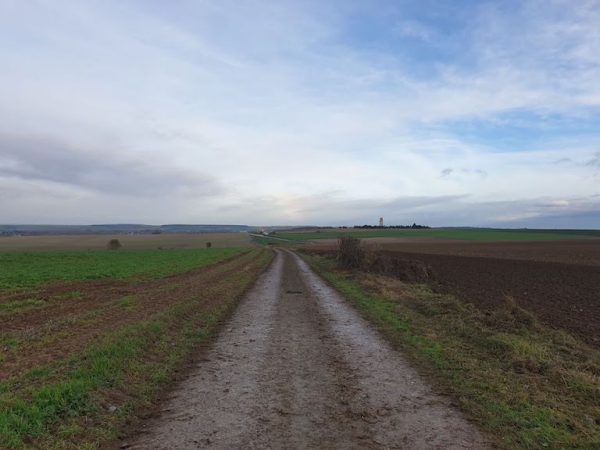
The walking track from Villers-Bretonneux to the Australian National Memorial, seen in the distance. Photograph by Elizabeth Heffernan, 2019.
On 25 April 1918, Australian troops of the 13th and 15th Brigades led the recapture of Villers-Bretonneux from the Germans during the First World War. Today we commemorate Anzac Day as the anniversary of the Gallipoli landings, but for the citizens of Villers-Bretonneux, both past and present, Anzac Day means liberation.
Last November, I had the pleasure and privilege of visiting Villers-Bretonneux and the Australian National Memorial for fallen soldiers on the Western Front built just outside town limits. The walking track from the village to the memorial is like a step back in time – turn your head from the houses behind and the monument ahead and the farmland that stretches between seems as though it could be the very same farmland from 1918, mud and trampled grass and all.
The memorial itself is breathtaking. Unveiled in 1938 just shy of the Second World War – and indeed enduring significant damage from the fighting – it consists of a military cemetery, tower, and Cross of Sacrifice that is present in all Commonwealth war cemeteries with forty or more graves. The sixty hornbeam trees originally planted in 1928 to line the cemetery were replaced in 2009 in preparation for the centenary commemorations of 2018. The new, state-of-the-art Sir John Monash Centre museum resides half-buried behind the main memorial, facing the rising sun, and was opened in April 2018. It hosts an interactive, multimedia exhibit that tells the story of Australia on the Western Front in the words of those who served. It is the largest Australian cultural institution outside the country. [1]
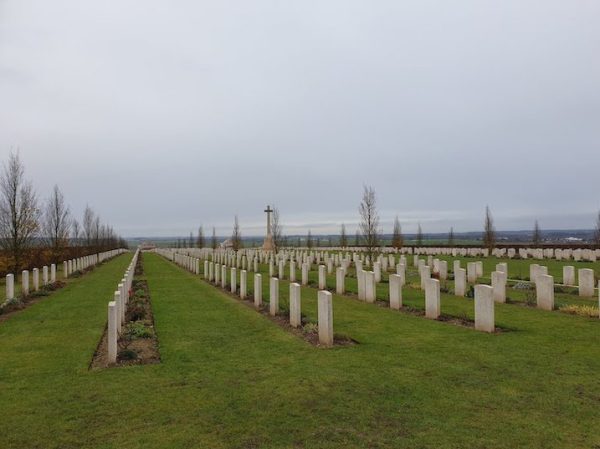
The Villers-Bretonneux military cemetery lined with hornbeam trees and the Cross of Sacrifice in the distance. Photograph by Elizabeth Heffernan, 2019.
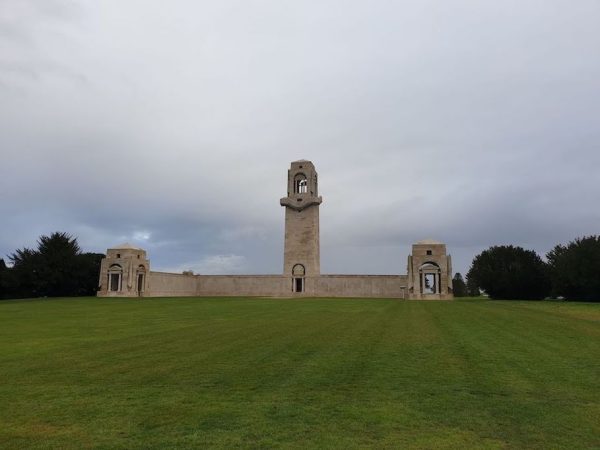
The Australian National Memorial. The new Sir John Monash Centre is situated behind the monument, half-buried in the ground with a grass roof so as to not detract from the memorial itself. Photograph by Elizabeth Heffernan, 2019.
Both the town of Villers-Bretonneux and the memorial and museum are highlights on the Australian Remembrance Trail along the Western Front. The trail stretches for two hundred kilometres through France and Belgium; among its other destinations include Amiens and Pozières to the south, Ypres and Messines to the north, with Arras, Fromelles, and Bullecourt between. Villers-Bretonneux is one of the better-known sites on the trail, not only for the actions of the Australian soldiers who fought and died there, but for the unique remembrance of the village itself.
After the war destroyed the town’s school for boys, Australian soldiers along with the Victorian Department for Education raised the funds to build a new school in its place, renamed École Victoria (Victoria College) and inaugurated in 1927. The words ‘Do not forget Australia’ adorn the outdoor playground shelter, and are repeated in French – ‘N’oublions jamais l’Australie’ – inside every classroom. In 1975, the Franco-Australian Museum was opened on the first floor of the school, funded in part by the Australian Government with a collection exclusively formed by donated material that continues to be received today. Even a bar named Le Melbourne, located on the main street Rue de Melbourne, stands as a testament to the shared history, respect, and compassion between Australia and a tiny French township half a world away. [2]
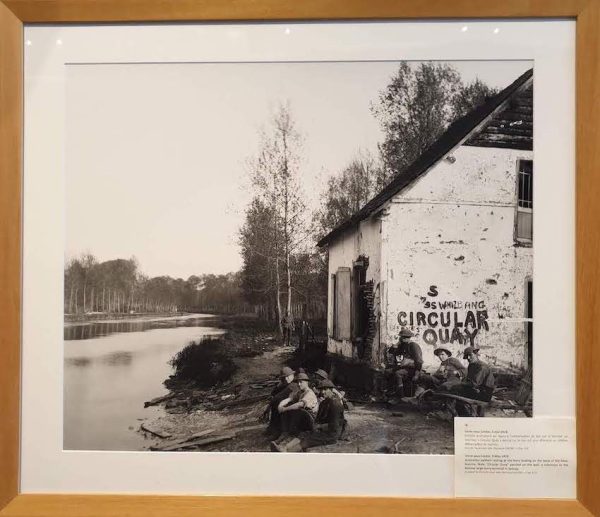
Photograph from the Franco-Australian Museum. Caption reads: Vaire-sous-Corbie, 5 May 1918. Australian soldiers resting at the ferry landing on the bank of the River Somme. Note ‘Circular Quay’ painted on the wall, a reference to the famous large ferry terminal in Sydney. Donated by the Australian War Memorial. Photograph by Elizabeth Heffernan, 2019.
That compassion endures, one hundred years on. On 2 February this year, the Villers-Bretonneux community organised a walk from the town to the memorial to raise funds and awareness for the horrific bushfires of last summer. The Australian Ambassador to France, Brendan Berne, was in attendance along with seven hundred concerned citizens. The walk, and the online fundraiser also initiated by the townspeople of Villers-Bretonneux, raised more than $37 000 for the bushfire cause. Some of the funds went directly to the firefighters of Robinvale, Victoria, the sister town of Villers-Bretonneux since the war, while the rest was donated to the Bega Valley Shire devastated by the fires. Villers-Bretonneux children, beneficiaries of the school rebuilt by Australian soldiers after the war, drew pictures and wrote letters that were sent to fire brigades across the country. [3]
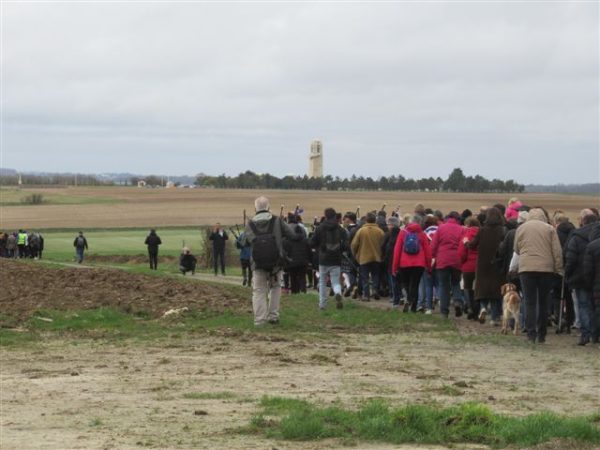
Residents of Villers-Bretonneux walking to the memorial for bushfire awareness. Photograph by Marie-Paule Bonte, 2020.
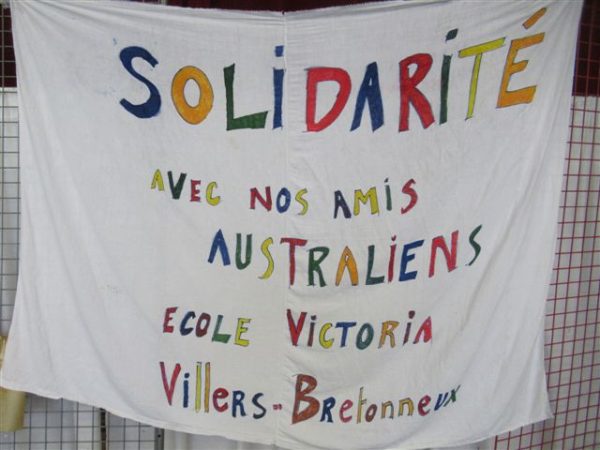
A sign from the Villers-Bretonneux walk. Translation: Solidarity with our Australian friends. Photograph by Marie-Paule Bonte, 2020
In the light of the COVID-19 epidemic, Villers-Bretonneux has cancelled their 2020 Anzac Day commemorations, as has every town, city, and state in Australia. But cancellation does not mean forgetting, and indeed, solidarity with our friends worldwide is needed now more than ever. One hundred and two years have passed since Australian soldiers liberated Villers-Bretonneux and helped turn the tide against the German Spring Offensive of 1918. That’s one hundred and two years of healing, of rebuilding, of innovating, of moving forward. The town of Villers-Bretonneux today stands as a testament to the men who fought and died for it – who are buried there, or whose names are inscribed on the list of more than 10 700 combatants who have no known graves.
Visiting the memorial at Villers-Bretonneux, I was struck, more than anything, by the quiet. It is hard to imagine one war being fought here, let alone two. Yet history remembers, even if the earth forgets. As one soldier so aptly phrased it, three days after the landings at Gallipoli:
I wonder what this valley will be like when there is no longer noise of fighting, no longer the hurried tread of combating forces—when the raw earth of the trenches is o’erspread with verdant grass … in the clear sky overhead, instead of the bursting shrapnel, little fleecy clouds—the scream of shrapnel, the Hell noise of the firing, giving place to an unbroken stillness save for the chirping of a bird or the soft buzzing of the bee! I wonder would it be thus!
Ellis Silas, 28 April 1915, in diary August 1914–26 June 1916, revised transcript of original, Mitchell Library, State Library of New South Wales, MLMSS 1840.
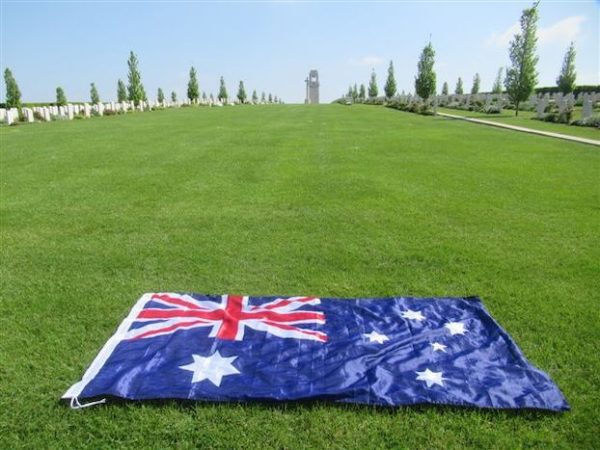
An Australian flag laid on the grass surrounding the memorial at Villers-Bretonneux. Photograph by Marie-Paule Bonte, 2020.
References:
[1] Elizabeth Mismes, ‘Guided Tour: In Memory of Australian Soldiers’, in Centre Sir John Monash: Villers-Bretonneux, ed. Claude Pommereau (Paris: Beaux Arts & Cie, 2018), p. 26.
[2] ‘Southern Region – Villers-Bretonneux’, in Australian Remembrance Trail along the Western Front: A Traveller’s Guide (Canberra: Department of Veterans Affairs, 2018), p. 22.
[3] ‘French raise money for bushfires’, Department of Veterans Affairs, 4 March 2020, accessed 22 April 2020, <https://www.dva.gov.au/newsroom/latest-news-veterans/french-raise-money-bushfires>.

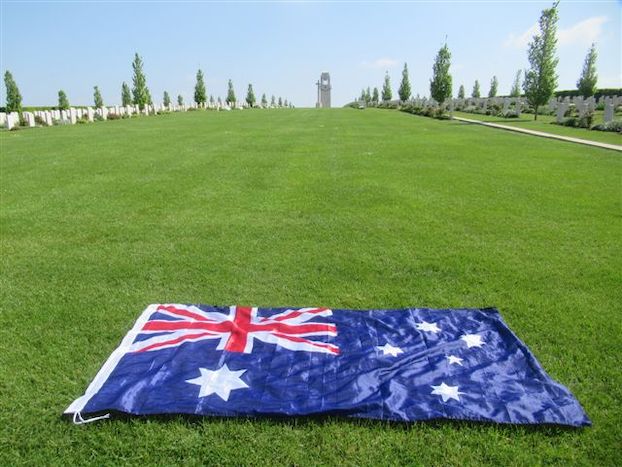
0 Comments